
Home
Preamble
Index
Areas
Map
References
Me
Drakkar
Saunterings: Walking in North-West England
Saunterings is a set of reflections based upon walks around the counties of Cumbria, Lancashire and
North Yorkshire in North-West England
(as defined in the Preamble).
Here is a list of all Saunterings so far.
If you'd like to give a comment, correction or update (all are very welcome) or to
be notified by email when a new item is posted - please send an email to johnselfdrakkar@gmail.com.
179. A Kendalian Intermezzo
I had a date with the Westmorland Orchestra at the Parish Church, Kendal and I thought I’d fulfil
it by walking from Windermere. But it was too hot for that. I settled for a saunter around Kendal.
Some readers have commented that my outings are too energetic to be considered saunters.
This one was not energetic enough. It was only afterwards that I thought I’d amuse myself with these words.
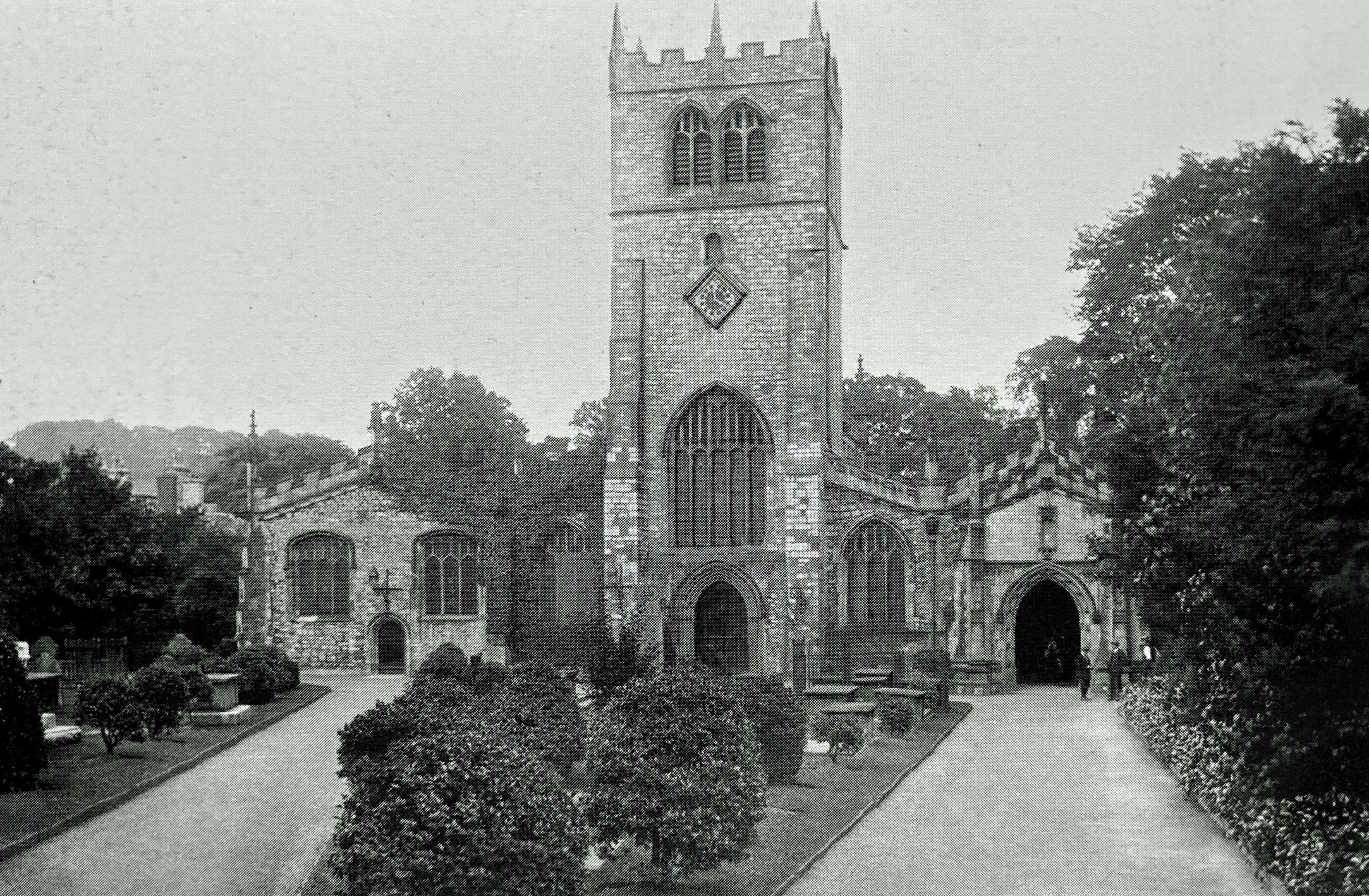 Right: Kendal Parish Church, 1914. (My camera took a break from Sauntering too. I'll use a few old
photos - about as old as the music I was to listen to.)
Right: Kendal Parish Church, 1914. (My camera took a break from Sauntering too. I'll use a few old
photos - about as old as the music I was to listen to.)
I walked to the river where I found an unoccupied shaded bench. It seemed wise to
rest upon it, and all other unoccupied shaded benches that I saw, for a few
minutes.
The river was very
low with pretty floating carpets of white flowers (that may be water crowfoot or water starwort, I read).
All the many weirs were revealed. Most of them are so low themselves that they cannot
have been functional weirs in the sense of serving some riverside mill. Probably they were just
to pause the flow of the river, which is notoriously liable to flood the town of Kendal.
There were many notices by the riverside path advising me of the extensive works underway
to protect Kendal. I understand that these plans are controversial locally but I cannot comment
in detail. I can only hope that the Kendal Flood Risk Management Scheme proves to be £76 million
well spent.
I ambled on, past Stramongate Bridge, over the new footbridge, back over the A6
bridge, past Beezon Fields, which notices said had been restored but looked little different to me,
on nearly as far as the railway bridge, and then turned
away from the river. It became hotter, noisier, and sweatier. I was in need of an ice-cream.
As usual, when I needed one I couldn’t find one. Eventually, I found a place to queue for
my rum-and-raisin, and as I waited a lad walked up with his half-consumed ice-cream and
threw it in the bin. His father walked by and said that he always does that. Well, it’s
none of my business but I think that the father needs to have a serious discussion. It is
against all known natural laws for a child to throw half-an-ice-cream away.
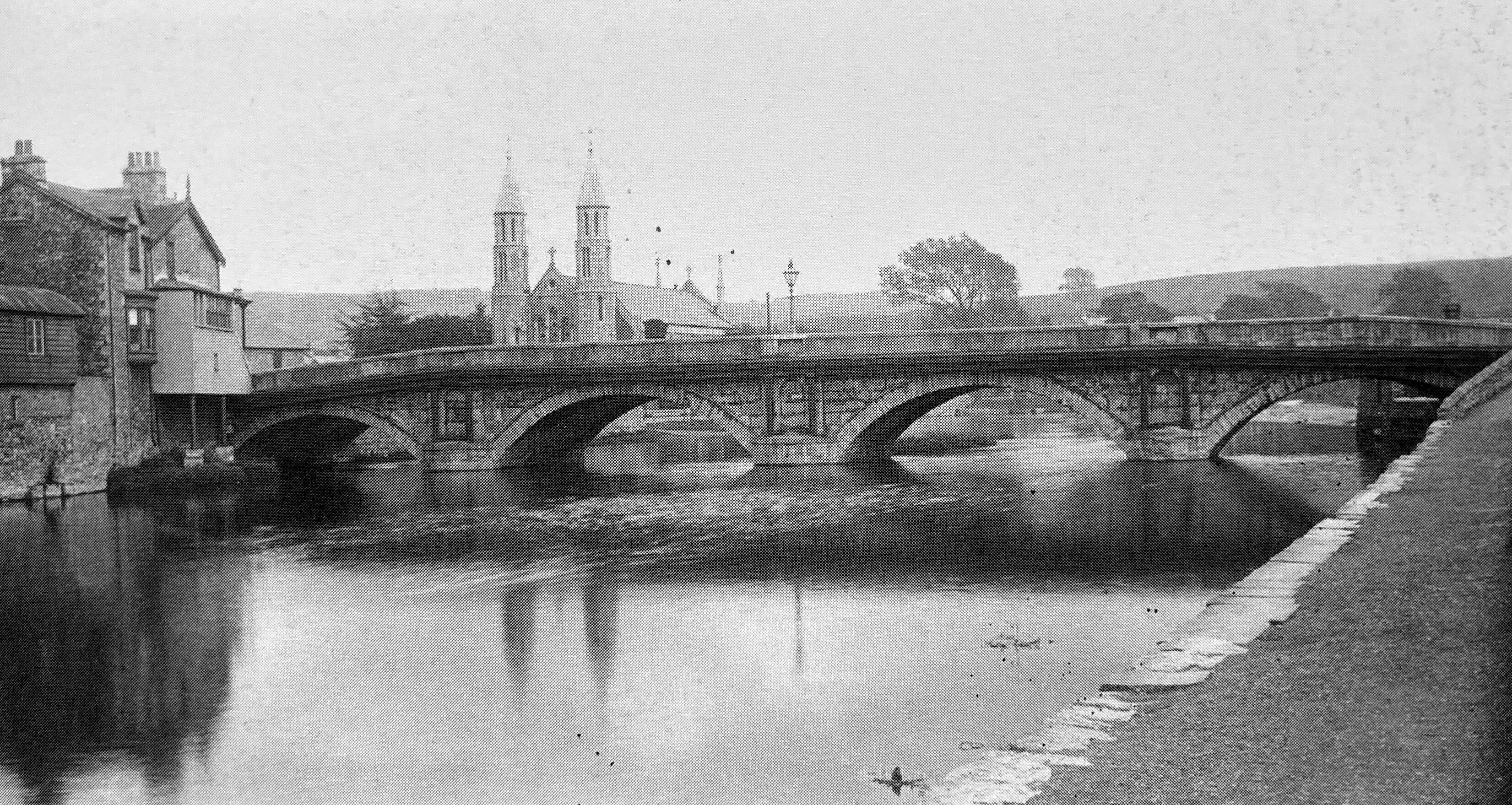 Left: Stramongate Bridge, 1891.
Left: Stramongate Bridge, 1891.
I settled with my rum-and-raisin in the shade of Westmorland Shopping Centre in
Stricklandgate. It is good to see that Westmorland, despite being abolished in 1974,
lives on. After the ice-cream I retired to the cool of Waterstones, where I read through
most of the books on the travel-writing shelves. I don’t actually buy books in Waterstones
anymore – not after my experiences trying to sell
The Land of the Lune.
I found that,
although 99% of the sales were local, Waterstones would only sell the book if I sent
parcels of the books to their warehouse in Folkestone, from which the books were parcelled
back to Lancaster. One Christmas the parcels couldn’t keep up with the sales, so I
arranged with the Lancaster Waterstones manager to smuggle books in by the back door
while he somehow fooled the computer to let him sell books he didn’t (according to
the computer) have.
It is a shame that this farcical system
has led to the demise of so many independent booksellers.
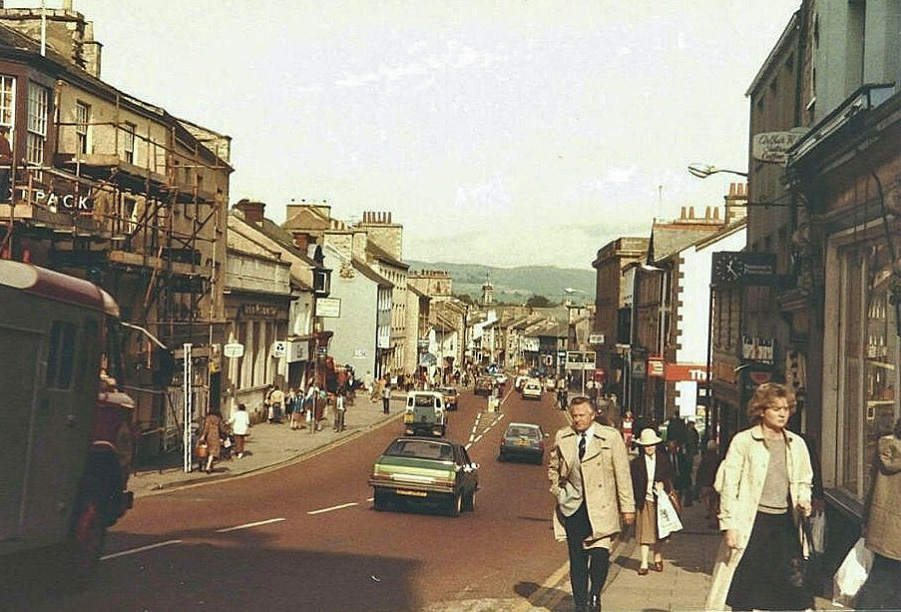 Right: Stricklandgate, 1984 (before it was pedestrianised).
Right: Stricklandgate, 1984 (before it was pedestrianised).
Emerging into the sunshine, I thought that I deserved a cappuccino. I sat for
quite a while on Highgate (the A6 through Kendal), with a view of the Town Hall, which
was flying a large Ukrainian flag, as was the Parish Church. After meeting up with Ruth
for between-rehearsal-and-concert fish-and-chips, I entered the sweltering church and
settled in my pew. The conductor gave us a warm welcome but it was more than warm – too hot
for hundreds of people to sit together motionless for two hours. But we had to.
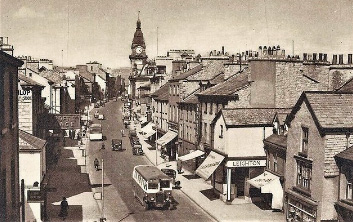 Left: Highgate and Town Hall.
Left: Highgate and Town Hall.
The programme was all-Russian, which with the Ukrainian flags aloft set me thinking.
I often wonder as I am sat in a concert what is passing through the heads of all the other
people sat there. Are they all 100% focussed on the music – unlike me. I don’t know enough
about classical music for it to keep my brain fully occupied.
I once took a course on Russian music. On reflection I think I was less interested
in the music per se than in the context in which it was written. In the mid-19th century
some Russian composers began to seek a distinctive Russian style of classical music, different
from the established western European traditions. So even then Russia was grappling with
its semi-detached European status.
Borodin (1833-1887), the composer of the first piece on the programme, the
Overture to Prince Igor, was a member of the ‘Mighty Handful’ of explicitly Russian
composers. Borodin was less dogmatic than the others, partly because he was only a part-time
composer. He was a chemist by profession. I don’t know who Prince Igor was but I am certain that
he was Russian.
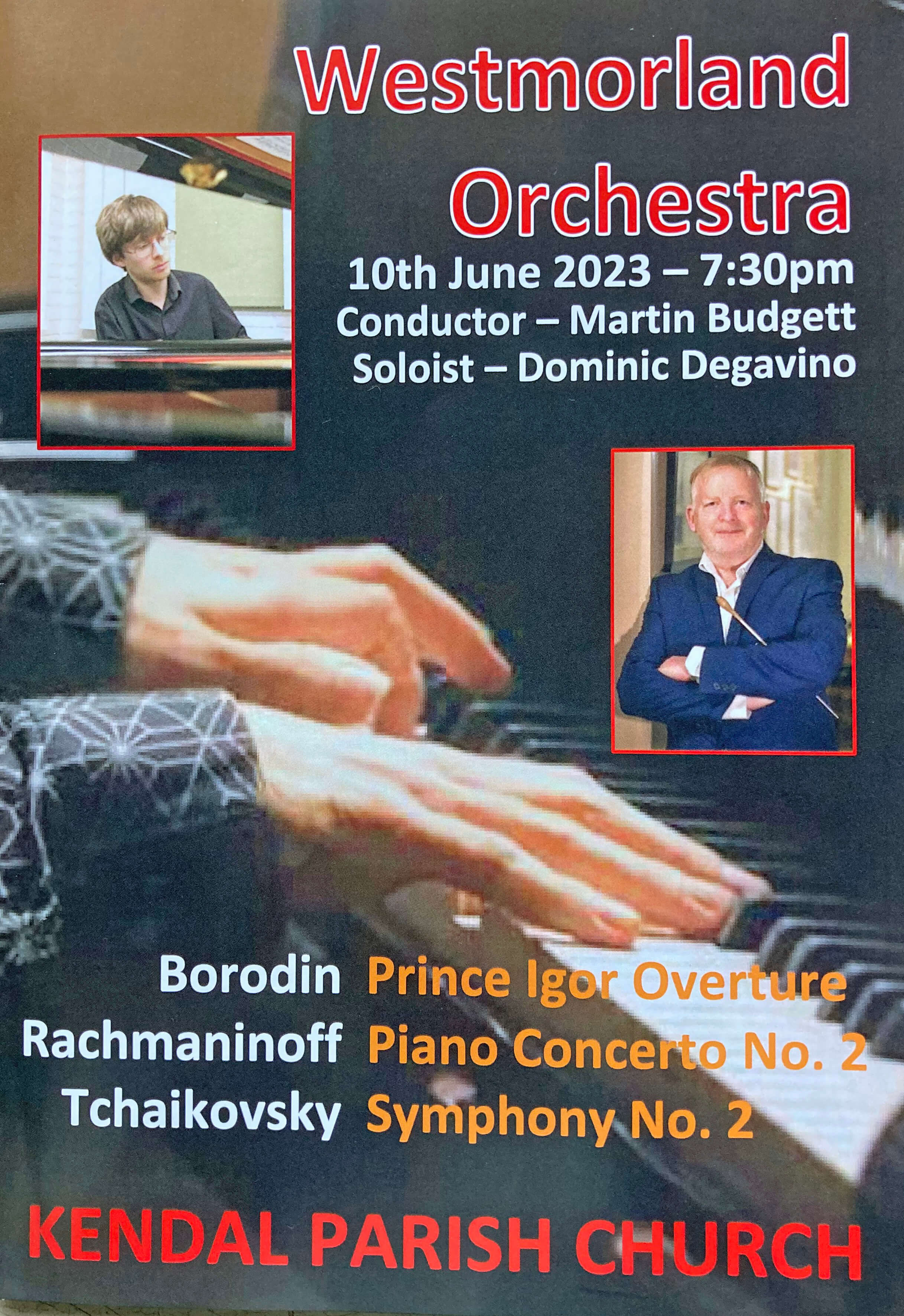 Right: The concert programme.
Right: The concert programme.
Next we had the 2nd Piano Concerto of Rachmaninov (1873-1943). Being of a later
generation, he presumably felt less need to proclaim his Russianness. He left Russia for
the USA in 1918, after the Russian Revolution. This piano concerto, composed in 1901, is too familiar,
partly because it was adopted for the film Brief Encounter, featuring Carnforth Railway
Station. By the end of the slow second movement 74% of the audience had drowsed off.
That’s an estimate since I had drowsed off myself. At least the third movement had some
rumbustious passages to wake us up for some interval fresh air.
And then it was back inside to sweat through Tchaikovsky’s 2nd Symphony.
Tchaikovsky (1840-1893) was of the same period as the Mighty Handful but he was not a
member of it. The 2nd Symphony is the most explicitly Russian of his symphonies.
Indeed, it is called the ‘Little Russian’, Little Russia being the name that (big)
Russia bestowed upon Ukraine.
Tchaikovsky once said that Glinka’s Kamarinskaya, composed in 1848, was the
acorn from which the oak of later Russian symphonies grew, which he tried to demonstrate
by writing the final movement of the 2nd Symphony in the Kamarinskayan style. A simple
motif 1-2-1-2-3-4-5-3-4-5, based on a Ukrainian folk song, is repeated
over and over ad nauseam
(and I do mean nauseam). It is not repeated
exactly but with slight changes in instrumentation, volume, and so on, sufficient
to ensure that any player that loses their place cannot easily regain it. Occasionally
a second, more lyrical motif intrudes and that too is repeated over and over.
We escaped from this battering into the first drops of a storm that never materialised.
This all-Russian programme was decided upon in 2021, before the Russian invasion of Ukraine,
and what would it achieve to change it? We are
supposed to appreciate works of art as supra-terrestrial, separate from our everyday concerns.
Is that possible? Isn’t when, where and why a piece of music
was composed – and is played – an essential part of its meaning? Who can today
listen to a concert of Russian music, with the flag of Ukraine flying above them,
without thinking of the Russia–Ukraine conflict?
Could we have had instead a concert of Cumbrian classical music? Probably not, for the
good reason that there isn’t much of it. Why hasn't the Lake District inspired
composers in the way that it has poets and artists? Have any famous composers visited
the Lake District, as, for example, Mendelssohn did Scotland? If so, were any inspired
to compose, as Mendelssohn was with Fingal’s Cave and the Scottish Symphony?
The most well-known – but hardly known at all – Cumbrian-born composer is probably
Arthur Somervell (1863-1937), son of the founder of K Shoes, a major employer in Kendal
for many decades. Judging from his list of compositions, even he wasn’t inspired to
compose music relating to the Lake District. There are, however, a few pieces that
declare an association with the Lake District and that could form an all-Cumbrian concert, such as:
* Tarn Hows – a
Cumbrian Rhapsody, by Maurice Johnstone (1900-1976).
* Lakeland
Summer Nights, by Arthur
Butterworth (1923-2014). (This is a work for solo piano. I don't know how many parts there are
to it. This link is to the second part, named 'Rain'.)
* Cloudcatcher
Fells (with sections named Great Gable, Grasmoor, and so on), by John McCabe (1939-2015).
* Symphony
No 3 (Westmorland) by Cecil Armstrong Gibbs (1881-1960). (This link is to just the first
movement. The other movements are on-line too.)
Would anyone come to listen?
Date: June 10th 2023
Start: SD516922, Kendal Parish Church (Map: OL7)
Route: E – River Kent – N, NE on west bank – new footbridge – E, N on
east bank – A6 bridge – SW, NW on west bank – near railway bridge – W, SW, SE – Stricklandgate –
S – Parish Church (with many pauses and slight diversions)
Distance: 2 miles; Ascent: 10 metres
Home
Preamble
Index
Areas
Map
References
Me
Drakkar
© John Self, Drakkar Press, 2018-

Top photo: The western Howgills from Dillicar;
Bottom photo: Blencathra from Great Mell Fell


 Right: Kendal Parish Church, 1914. (My camera took a break from Sauntering too. I'll use a few old
photos - about as old as the music I was to listen to.)
Right: Kendal Parish Church, 1914. (My camera took a break from Sauntering too. I'll use a few old
photos - about as old as the music I was to listen to.)
 Left: Stramongate Bridge, 1891.
Left: Stramongate Bridge, 1891.
 Right: Stricklandgate, 1984 (before it was pedestrianised).
Right: Stricklandgate, 1984 (before it was pedestrianised).
 Left: Highgate and Town Hall.
Left: Highgate and Town Hall.
 Right: The concert programme.
Right: The concert programme.
